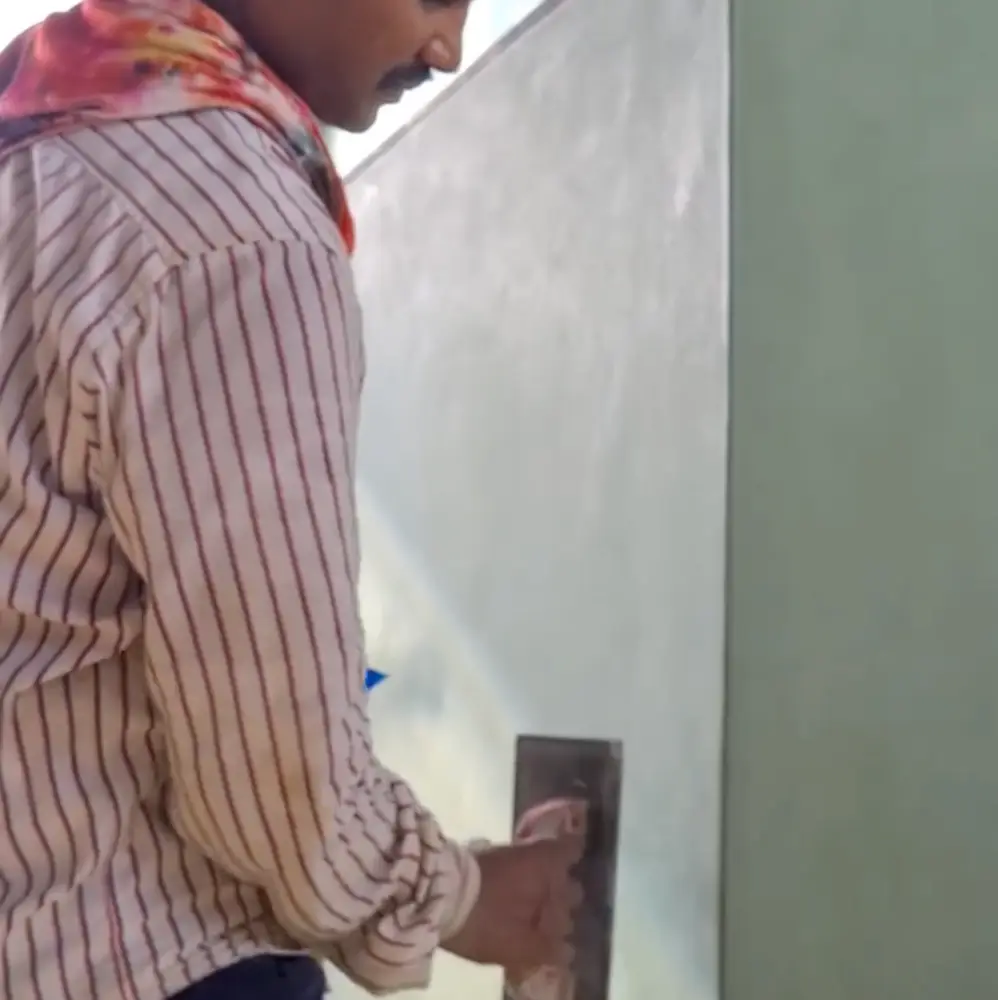In the heart of Morocco, a centuries-old tradition called Tadelakt lime plaster stands as a testament to the enduring beauty and craftsmanship of North African culture.
Tadelakt, derived from the Arabic verb "dlak," meaning "to knead," is a specialised technique used to create polished, waterproof plaster finishes.
Inspired by the texture of Tadelakt and awed by the rustic beauty and versatility of lime plasters that have been used extensively in heritage architecture in the region of Rajasthan, we chose to use Tadelakt lime plaster on the bathroom walls of the Earth House farmstay at Haribagh near Jaipur.

We always wanted to use natural building material throughout the construction process to minimise our carbon footprint and to add the elegance of lime to our project, and when we found expert contractors for the lime plastering in Manu and his team at Thumbimpressions LLC, we looked looked no further.
Lime plastering is a craft and requires both - skilled artisans for the application, and also experienced plaster planner to create the appropriate plaster mix for your geography, use and desired finish.
This article explores the history, unique properties, and contemporary relevance of Tadelakt lime plaster in both Moroccan and global architectural design.
A Glimpse into History
Tadelakt lime plaster finds its roots in Morocco, particularly in the city of Marrakech. With a history that spans over a thousand years, this technique was initially developed by Berber tribes in the Atlas Mountains. They used Tadelakt to waterproof cisterns and hammams (bathhouses), and it later evolved to become a staple in Moroccan architecture.
The Making of Tadelakt
Tadelakt is made using a mixture of lime plaster, Marrakech clay (we of course locally available clay), and natural pigments for colour based on the colour desired.
The plaster is skillfully applied to a substrate, typically a base of stone or brick, and meticulously polished to create a smooth, marble-like finish.
To achieve its characteristic glossy appearance and water-resistance, the plaster undergoes a unique process:
- Application: After the initial plaster coat, a second layer is applied, followed by a vigorous rubbing and polishing using a stone or trowel.
- Sealing: To make Tadelakt waterproof, it is treated with a mixture of olive oil soap or black soap, and water. This sealing process, often done multiple times, creates a hydrophobic surface that repels moisture.

Properties of Tadelakt Lime Plaster
Water Resistance: Tadelakt is renowned for its remarkable water-resistant properties, making it an ideal choice for wet environments like bathrooms, showers, and hammams.
Aesthetic Appeal: The polished finish of Tadelakt exudes a luxurious and timeless charm. Its soft, organic appearance and the option to include natural pigments provide endless design possibilities.
Sustainability: Tadelakt is an eco-friendly choice, as it primarily uses natural materials and consumes little energy during production.
Durability: When properly maintained, Tadelakt can last for generations. Its toughness and resistance to cracking make it an excellent long-term investment.

Contemporary Relevance
While Tadelakt has deep-rooted historical significance in Moroccan architecture, it has found contemporary applications worldwide.
Architects and designers appreciate Tadelakt for its unique blend of aesthetics and functionality, making it a sought-after material for both interior and exterior projects.
It's for this wholesomeness that Tadelakt provides with its supremely functional use and pleasing aesthetics that we chose to do Tadelakt lime plastering in all the bathrooms at the rammed earth farmstay at Haribagh at Jaipur in Rajasthan, India.

While the rammed earth walls provide a sense of rusticity and bring us closer to the earth, the lime plaster provides a timeless elegance to the walls in the bathing area while protecting the rammed earth walls.
When you come to think of it, Tadelakt lime plaster is more than a building material, it has a character of its own and is now part of a cultural heritage that has captivated the world with its timeless beauty and exceptional properties.
As architects and designers continue to appreciate the unique qualities of Tadelakt, it continues to bridge the gap between tradition and modernity, offering a glimpse into the rich history and enduring craftsmanship.
This enduring art form is a testament to the idea that heritage and innovation can coexist, creating spaces that are both functional and exquisitely beautiful.
Step in to Earth House at Haribagh, Jaipur to experience the beauty of rammed earth and Tadelakt lime plaster.














